

Many of the Nazi ceremonies took place in the large open area in front of the Residenz, the 18th century rococo palace of the Prince-Bishops of Würzburg. On 10 March 1933, the newly-empowered Nazis burned pamphlets and writings by Communists here in the Residenzplatz. In this photo, Adolf Hitler visits on 27 June 1937.
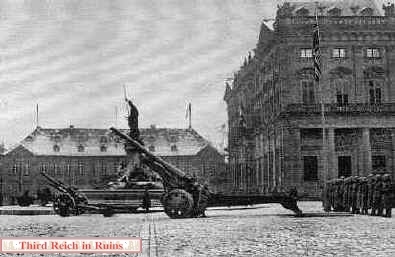
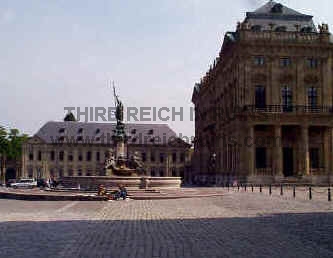






The Luitpold Arena could hold over 150,000 Nazis, and was the scene of SS and SA gatherings. At one end was the Ehrenhalle, a war memorial built in 1929. The arena is now a large grassy park, very popular on sunny afternoons. Only the Ehrenhalle is left at this end, the adjacent grandstands having been removed


A group of young girls parade in the Coburg Hauptplatz, giving the “Hitler-Gruß” salute and singing the “Horst-Wessel-Lied,” the unofficial anthem of the Nazi Party. The modern views show a slightly wider angle to show more of the surrounding architecture, including the statue of Prince Albert of Saxe-Coburg, who married Queen Victoria of Great Britain


The Nazis held a parade through the Bavarian town of Vilsbiburg in 1927 in preparation for a speech by Hitler - SS chief Heinrich Himmler is seen leading the column. The scene today appears almost identical.


SS “Berghaus” rest and relaxation home, on the Sudelfeld near Bayrischzell in southern Bavaria. The home, which included tennis courts and a swimming pool, was built in 1937-38. It serves today as a Youth Hostel.


Looking out from the Marktplatz down Friedbergerstraße, toward the church.


This edifice was actually started in the 1920s as an observation platform, but was turned into a flag tower by the Nazis. (Note you can still see some of the Swastika)


The view from ground level, in front of the Ehrenhalle. The paving stones at the spot where Hitler stood have been removed by souvenir hunters


“At this wrecked bridge Staff Sgt. William H. Bowen, Jr., and Pvts. Harry A. Barker and McFarlan Barnson were captured the night of 6 May. The jeeps belong to the 101st party which came up on 7 May to arrange surrender terms with General Tolsdorf.” The modern photo is at a slightly wider angle, but a careful comparison of the mountain skylines and hillsides at the same scale, along with the curvature of the road, shows this to be the same location.





Hitler rests on the sun terrace during a private visit to the Kehlsteinhaus (probably in 1939). The arched terrace windows were glassed-in in the 1950s, and the terrace is used to serve the outside terrace restaurant today.

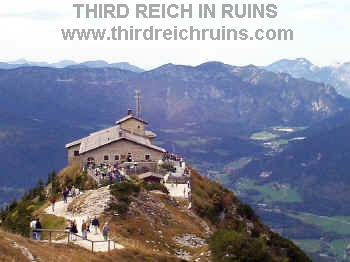
Kehlsteinhaus (Eagles nest)
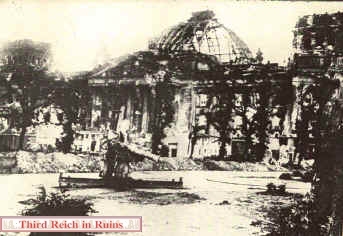
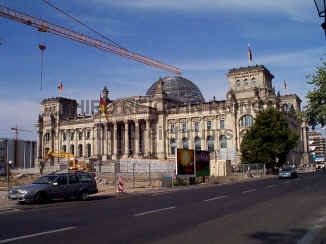
Reichstag


Buchenwald concentration camp


The ashes from the crematorium were taken out by the ramp seen in the period photo, and dumped into pits nearby. The modern photo shows this same tower and wall, from a slightly different angle
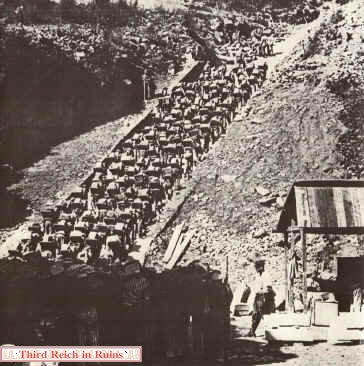
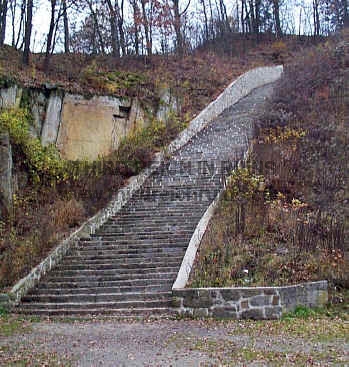
The infamous Todesstiege, or Stairway of Death. Prisoners were forced to carry quarried blocks of stone up these 195 narrow uneven steps, and on up to the upper level.
Heres a couple from one of the most rich WWII buidlings and history out there, Berchtesgaden-Obersalzberg though a lot of it is being bastardized


Members of the SA gather at the fountain in the main square in Berchtesgaden in the 1930s.


Elements of the 3rd U.S. Infantry Division moving into Berchtesgaden on 4 May 1945. The M4 Sherman tank was coming
from Bischofswiesen to the north, and had just passed through the small town of Stanggass. This photo was taken just up the street from the Berchtesgadener Hof hotel (see below) - the house in the background is called the Schönhäusl.


he armored force reaches downtown Berchtesgaden. These 3rd Infantry Division GIs riding on an M36 90mm tank destroyer are viewing the Berchtesgaden World War I memorial, painted on the side of the town hall. The memorial painting by Munich artist Josef Hengge now includes the dates for World War II
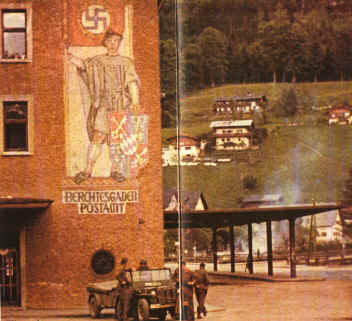
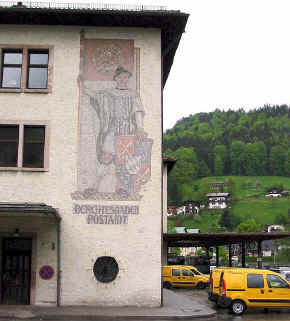
GIs at the Berchtesgaden Postamt (post office) in May 1945 - a still from color movie film by George Stevens. This side of the train station building (see below) is still the main post office - the only change to the mosaic has been the removal of the swastika from the flag.


Reichsleiter Martin Bormann house
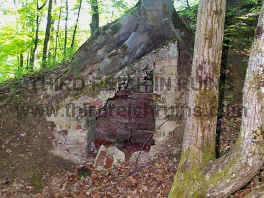
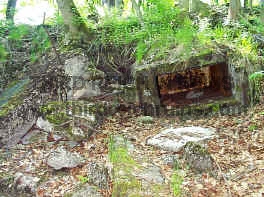
Examples of miscellaneous rubble pieces of Bormann’s house, which can be found today downhill from the house site. The emergency exit to the bunker system (on the right) is closed off by rubble several yards inside


Reichsmarschall Hermann Göring’s house

Similar view of the site of Göring’s house, taken in 2001 before the construction of the hotel on the hilltop. The circular water filled depressions in the center and right foreground are bomb craters remaining from the April 1945 attack. The hotel construction has radically changed this site


The Hotel Zum Türken as it appeared in May 1945, shortly after the Allied occupation, and as it appears today.

In common with most buildings on the Obersalzberg, the Hotel Zum Türken had underground passageways linking it to other buildings. In addition to the traditional air raid shelter/bunker system under the hotel, linking to the systems of Hitler and Bormann, a smaller access tunnel led behind the hotel and under the hill to the Modellhaus basement.

This view (which appears to be a composite photo) shows the location of the Mooslahnerkopf Teehaus,
in relation to the more famous Kehlsteinhaus (“Eagles Nest”), high on the ridge above. The so-called Eagles Nest
is often called “Hitler’s Tea House,” but this is technically incorrect. Hitler did not treat the Kehlsteinhaus
as a tea house, and the location he visited daily for afternoon tea was actually the Mooslahnerkopf Teehaus

Teehaus seen from near the overlook. Vegetation prevents a corresponding view today. This modern view shows the foundation ruins of the round part of the Teehaus.


The photo on the left is a still from period movie film. Eva Braun’s sister Gretl, along with adjutant Julius Schaub (on the left in uniform) look at the photographer, while others (including possibly Albert Speer and his wife) enter the Teehaus. (I believe the woman on the right is Hermann Esser’s wife.) This view shows the steps leading up to the Teehaus door - these steps still exist, as seen in the modern photo, shot from a position to the lower right of the period view.

Ruins of the lower part of the straight front wall

Inside the basement rooms of the Teehaus ruins.


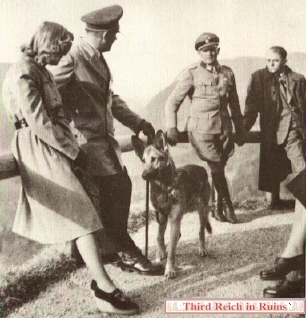

The walk to the Teehaus featured an overlook above the Berchtesgaden valley, one of Hitler’s favorite views.
(stuff below isnt of Berchtesgaden)


A U.S. Congressional delegation which was investigating Nazi concentration camps visited Dora on 1 May 1945.
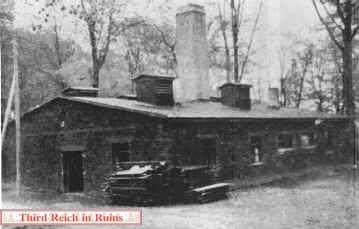

The crematorium for the Dora camp was not large, but was kept busy

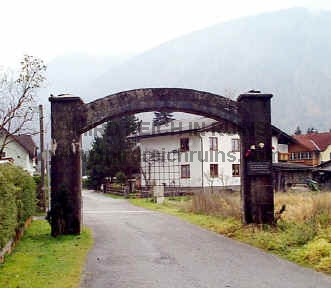
The main gate to the Ebensee concentration camp has been preserved as a memorial.




closer view of the knocked-out M4A3 Sherman tank that can be seen in the center distance in the previous photo. This tank was shot by a 15-year-old Hitler Jugend member with a panzerfaust, wounding the driver, who lost control. The tank made an abrupt turn and crashed into the store front of Hauptstraße 43, the butcher shop of Franz Mayer. Notice the sandbags placed around the hull and turret as extra armor (unsuccessful in this case). Another knocked-out Sherman can be seen behind it to the left. Amazingly, this store is still the Metzgerei Franz Mayer, hardly changed at all, allowing a perfect modern match.


A short distance upriver is the picturesque town of Gemünden, famous for its three rivers and the ruins of Schereburg fortress. During fighting on 4-5 April 1945, Gemünden was practically destroyed. The bridge over the Fränkische Saale River had been blown a week earlier, during the abortive American attempt to liberate the Hammelburg POW camp (Task Force Baum). One would not realize this destruction today - even the ruins of the castle were cleverly rebuilt.


GIs of the 62nd Armored Infantry Battalion, 14th Armored Division, fight their way through the ruins of Gemünden. This photo was taken by an Army Signal Corps photographer on 6 April 1945. This scene has changed very little (except the street has been widened - the building on the left is no longer there)
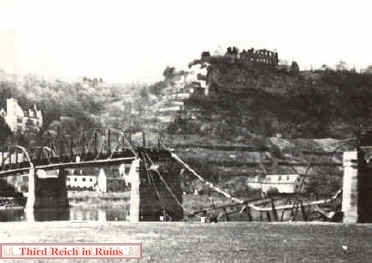

Karlstadt is the next town upriver from Gemünden. The town was bombarded with artillery from 3-6 April 1945, and troops of the U.S. 42nd Infantry Division entered the town on 7 April. The bridge over the Main River had been blown on 27 March. A new bridge was built on the old piers, but the ruins of the Karlsburg fortress remain unchanged on the hill beyond.
Here are some pictures of Flossenburg, Dresden was a subcamp of Flossenburg.

This building, the former SS administrative building of the Flossenbürg concentration camp, 1995 was an apartment building located outside of the Memorial Site of Flossenbürg.


A former officer’s baracl.


he former camp building housing the latrine and Appelplatz (open area). These were located outside of Gedenkstätte Flossenbürg.


The “shooting wall” 50 years ago and what remains of it today. The foundation and back wall in this photograph taken in 1995 is what remain of the former kitchen, next to the shoting wall.
Auschwitz Memorials and Displays

Temporary gas chamber used during 1941 and 1942
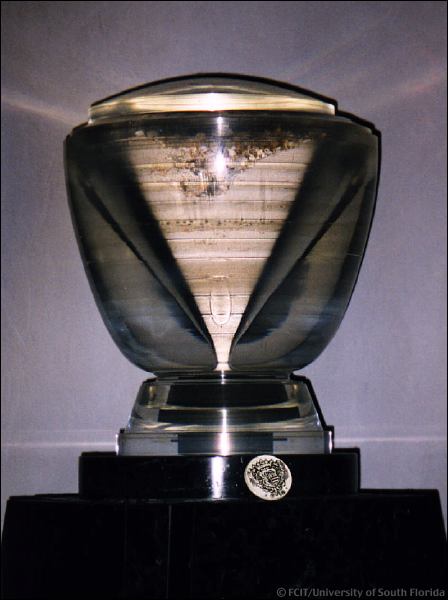
Urn of human ashes.
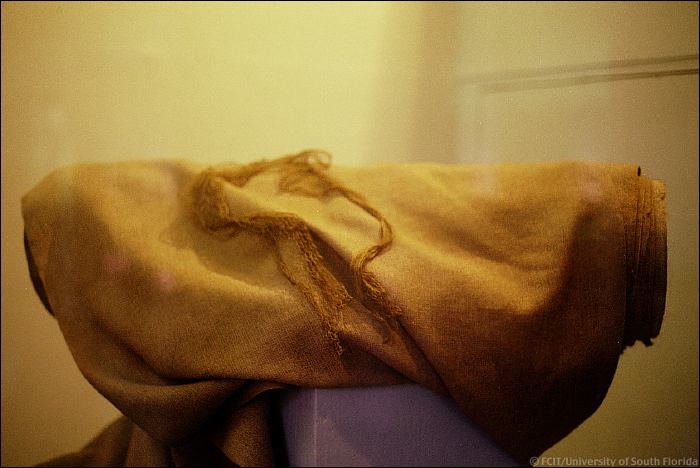
Cloth made from human hair. Seven tons of human hair were found in the camp warehouses.
Bergen-Belsen
Mass grave
View of the memorial site. To prevent the spread of disease, British troops burned all of the camp buildings in May of 1945.
Buchenwald
Ring Tomb. At least 2,900 Buchenwald victims were buried in natural depressions at this site in March and April of 1945. This is the first of three depressions incorporated into the memorial design.
Drancy
Approaching the boxcar from the memorial. This boxcar was used to transport French Jews to Nazi extermination camps. They were kept at Drancy and then taken to the train station at Bobigny where they were then transported to Auschwitz
Majdanek
Mausoleum designed by Wiktor Tolki. The structure covers a huge mound of human ashes. The engraved sign cautions, “Let our fate be a warning to you.”
Huge mound of human ashes from the prisoners who were murdered at the camp.
A display of human remains from the camp.
A gravestone marker amid mounds of graves. The town of Lublin can be seen in the distance.
A monument designed by Albin Maria Boniecki while he was an inmate at the camp. Three eagles, symbolic of Poland, sit on an urn containing human ashes.



